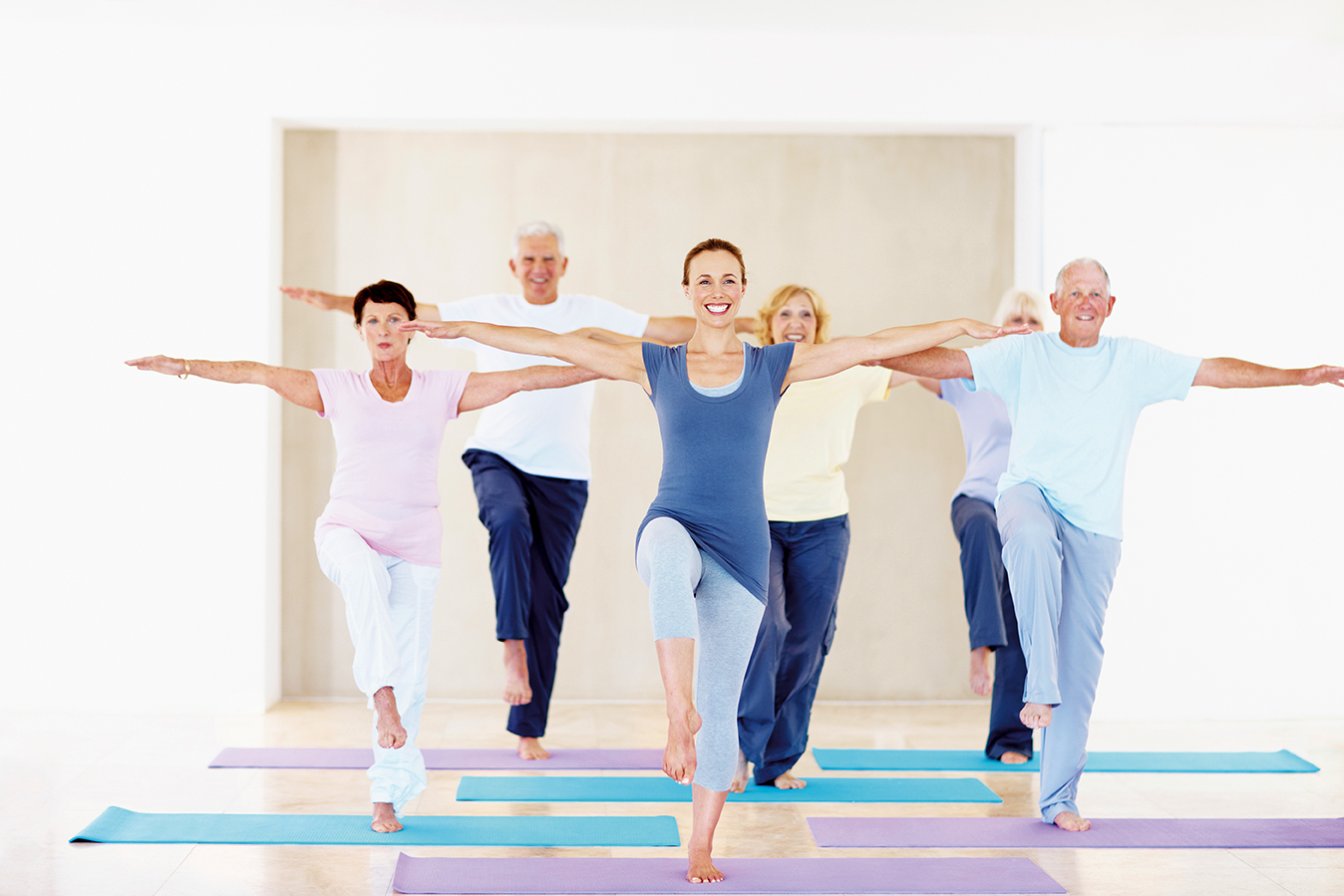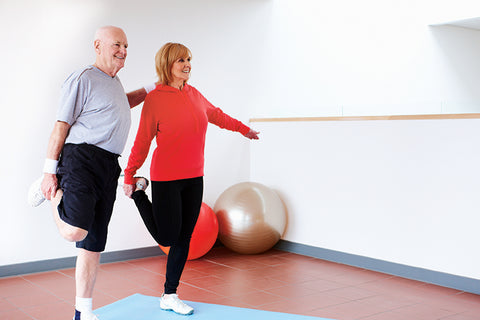There are steps you can take to reduce your chances of falling
By Wendy Haaf
One night last summer, Kerry Delaney was dog-sitting in a house where she’d stayed before when she got out of bed and shuffled down the hallway, still half-asleep, to use the washroom.
“I guess I was doing the old eyes-closed shuffle along. I took that last step—and down the stairs I went,” she recalls.
The 63-year-old from Whitby, ON, broke her wrist and suffered a compound fracture of the femur in one leg, meaning the jagged end of the bone pierced her skin. “I was lucky,” she says, “because it came close to puncturing the femoral artery, and if that had happened, I would have been dead in 10 minutes.”
Unable to move and alone in the house with no phone within reach, Delaney sat at the bottom of the steps all day, waiting for a friend who was scheduled to drop by for a swim at 5 p.m.
Every year, roughly one-third of people aged 65 or older will experience a fall, and about five to 10 per cent of those falls will result in serious injury, says Kim van Schooten, a researcher with the University of British Columbia’s Centre for Hip Health and Mobility and Simon Fraser University’s Department of Biomedical Physiology and Kinesiology. According to the Canadian Institute for Health Information, falls are the leading cause of injury-related hospital stays in this age group, contributing to 73,190 hospitalizations in 2008–2009. In the 2009–2010 Canadian Community Health Survey, 256,011 older Canadians reported experiencing some type of fall-related injury in the previous year.
Falls are behind 95 per cent of hip fractures, according to a report from the Public Health Agency of Canada, leading to death in 20 per cent of cases and long-term disability in another 50 per cent. Overall, “About seven deaths a day can be attributed to the consequences of falls,” van Schooten says.
If falls in later life are so common, are they an inevitable, normal part of aging? In a word, no. While some falls (like Delaney’s) may not be avoidable and not all of the risk factors for falling can be changed, there are steps you can take—starting right now—to reduce your chances of falling and of suffering a serious injury if you do take a tumble.
Hone Your Balance
Balance involves integrating input from a complex system that involves sensors throughout the body, including in the limbs, and a sort of gyroscope in the inner ear. Long before we reach age 65, normal changes begin taking place that make that system less efficient.
“Balance function begins to decrease at about age 40 for women,” says Susan Hunter, an assistant professor at the School of Physical Therapy at Western University in London, ON. However, just as you can offset the natural decline in muscle strength that occurs as we age by working out with weights or resistance bands, you can do exercises that challenge and bolster your balance.
How you go about doing this depends in part on how well your sense of balance is working to begin with. If it’s working below a certain threshold, Hunter says, you’ll benefit from some individualized training from a physiotherapist to get you started. She suggests the following self-test: use a stopwatch to time how long you can remain standing on one leg. “You should be able to stand for 30 seconds with your eyes open and about 30 seconds with your eyes closed,” she says. If you’re managing less than 27 seconds with your eyes open, a physiotherapist should be your first stop.
What should you look for in an exercise program that will help build your balance? “For balance to get better, exercises have to be moderately to highly challenging,” Hunter says. Three criteria: you need to move (as opposed to standing only); you need to vary the size of your base of support (from feet next to each other to a shoulder-length apart, for instance); and you need to minimize your use of upper body support.
“Most people will stand on one foot and, if they start to feel wobbly, grab onto something,” Hunter says. “You need to be able to wobble and recover.”
Tai chi and yoga are two systems of exercise that incorporate these principles. Judo and other disciplines that incorporate lessons on how to fall and get up afterward may also be useful. “Learning how to land safely seems to decrease the risk for injury when people fall,” van Schooten says.
Aim for two weekly sessions of at least 15 to 20 minutes each, and don’t be discouraged if you don’t see immediate results—Hunter says it will take about 50 hours of practice before you see an improvement. And you have to stick with it. “Even at younger ages, it doesn’t take long for our bodies to decompensate,” Hunter says. On the other hand, she says, “we know that for older adults, there’s no upper age limit for when people will stop getting a benefit. If you follow an exercise program, your cardiovascular fitness will improve, your strength will improve, and your balance will improve. It may take a little longer, but you will still see the effects of training.”
Stay Active
Physical inactivity is probably the leading modifiable risk factor for falling. “Only about 30 to 50 per cent of older people move sufficiently,” van Schooten says, meaning that they meet the recommended target of 150 minutes of moderate (or 75 minutes of vigorous) activity per week. Moderate physical activity, which should noticeably increase your heart rate, includes brisk walking, bicycling, gardening, and dancing; the more vigorous variety includes pastimes that also trigger more rapid breathing, such as hiking, jogging, and swimming. All of these exercises also help keep leg muscles strong, a factor that’s also been linked to a lower risk for falls. (By contrast, needing to use your hands when you get up out of a chair is a red flag.)
The connection between physical inactivity and fall risk may also provide at least a partial explanation of two other fall risk factors that researchers have identified: depression and fear of falling, both of which can cause people to sharply curtail the amount of time they spend engaged in physical endeavours.
Review Medications Regularly
The latest studies show that taking multiple medications contributes to a high risk for falls in older people, says Ramona Gheorghe, a registered nurse with the Falls Prevention Clinic at the Toronto Rehabilitation Institute. “Anything more than three medications puts people at a higher risk.” That’s not only because the more drugs you’re taking, the greater the chance of an interaction, but because the way the body handles drugs also changes as we get older. That’s why, for example, we become more sensitive to alcohol as we age.
“People should ask, ‘Why exactly am I taking this medication and for how long? When am I supposed to stop?’” Gheorghe says. “I encourage people not to be afraid to ask questions of the doctor or pharmacist and to review their medications with the pharmacist at least once a year.”
Gheorghe also underlines the importance of asking similar questions each time you start a new medication and of reporting back to the doctor right away if, after doing so, you begin experiencing side effects such as dizziness or blurred vision.
It’s also worth being similarly cautious with over-the-counter preparations, such as older antihistamines, that can cause side effects such as drowsiness.
Keep Tabs on Your Senses
Loss of vision and loss of hearing are both tied to an increased risk of falling, so it makes sense to see your optometrist for a routine eye exam at least once a year and to have your hearing checked periodically, particularly if you are having any problems with dizziness or unsteadiness.
“Some people think dizziness is just part of being older, but it’s not,” emphasizes Janine Verge, an audiologist with the Nova Scotia Hearing and Speech Centres at the QEII Health Sciences Centre in Halifax. She says the first step in trying to identify the cause behind dizziness is a hearing test. “If there’s something going on with the vestibular [balance] system, the hearing may provide signs,” she explains. “Certain types and patterns of hearing loss can help us figure out exactly what’s going on.”
Some of these balance problems can be fixed or managed with the help of an audiologist specializing in vestibular rehabilitation. For instance, about 50 per cent of cases of dizziness in older people are caused by a condition in which tiny crystals deep within the inner ear that play a role in sensing gravity and head movements become dislodged and begin to drift. A series of special rehabilitation exercises can often coax these crystals back to where they belong.
If you’re having balance problems or experiencing spinning sensations or dizziness, Verge suggests keeping a diary to detail when and how often symptoms occur, including whether they come on during particular activities or movements, and to note any associated factors, such as a fluctuation in hearing or ringing in the ears. These details can be helpful in making an accurate diagnosis.
Periodically having your feet and legs checked to ensure the nerves in those areas are functioning normally is also a good idea, since, Hunter says, “decreased sensation will affect balance.”
Get With the Program
Another powerful risk factor for falling is a previous fall. And while you can’t go back in time to prevent that first fall from occurring, you can alert your doctor so that you get personalized help to address any contributing factors.
“Identifying as many risk factors as possible and then providing individualized treatment can lower fall risk by about 30 per cent,” Hunter says.
As a former nurse, Anna Ade, 88, knew to raise this subject with her doctor a few years ago after experiencing a few minor falls. “She said, ‘I’m going to send you somewhere where you will be learning special exercises,’” Ade says. Ade attended a 12-week program at Toronto Rehabilitation Institute that incorporated an extensive initial assessment by an interdisciplinary team of professionals with exercise classes and informational sessions on topics such as getting rid of potential household hazards such as throw rugs and poor lighting. “The progam combines strengthening, balance, and aerobic exercise,” explains Aliza Neuhof, a physiotherapist with the Falls Prevention Clinic.
After attending, Ade continued to do the exercises regularly in addition to walking for half an hour nearly every day. She was prescribed a cane, which she uses for a little extra support (“I’m not ashamed; I have to do what I have to do,” she says), and she takes periodic breaks to rest her legs. “Thanks to the cane, thanks to the exercises from the nurses and physiotherapists, I am walking very well,” she says. In fact, she hasn’t fallen again since completing the program.
What of Kerry Delaney? After three surgeries, two months in hospital, and 12 weeks of outpatient rehabilitation, the avid bicyclist, skier, and snowshoer (who also worked out regularly before her accident) is well on the road back to being her former active self—but the outcome might have been quite different.
“Even if it’s an accident and you can’t prepare,” she says, “there’s huge value in being in shape beforehand. I wouldn’t be where I am in my recovery now if I hadn’t been healthy and in good physical shape.”
Canadian Innovations
Canadian researchers are working on ways to change our everyday environment, including the things that we use to interact with it, to help address falls as a public health issue. “By changing the environment, you can directly reduce the risk for injuries,” says Tilak Dutta, a research scientist and lead of the Home and Community Team at the Toronto Rehabilitation Institute’s iDAPT Centre for Rehabilitation Research. Some recent advances include:
- An easily installed, temporary support system. “A scenario we often think about is an older adult who, say, has had a stroke and is coming home from hospital and is now using a wheelchair,” Dutta says. This person needs the assistance of a spouse, a partner, or another caregiver to help with bathing and using the washroom. During this transitional period, both the patient and his or her caregiver run an increased risk for injury and falls. To help offset that, Dutta and his team created a system of supportive poles that can easily be installed without drilling holes or making any other modifications to the home.
“It’s a very quick, temporary installation: you just tighten a nut and it expands between the ceiling and the floor,” Dutta explains. Putting a support next to the bed can also enable someone to get to the washroom without assistance. “That means he or she will move more, rather than wait for the caregiver or personal support worker,” Dutta notes.
- Hip protectors and forgiving flooring. Kim van Schooten, a researcher with Simon Fraser University’s department of Biomedical Physiology and Kinesiology, works with the Canada Research Chair in Injury Prevention and Mobility Biomechanics, Stephen Robinovitch. “Our preliminary data have shown that compliant flooring and hip protectors can decrease forces [from falls] to the head and hip by up to 80 per cent,” she says. “Environmental adaptations such as these may be very valuable in settings where other interventions may be less effective, such as long-term care facilities.”
- A grading system for winter footwear. When you’re buying boots, you generally look at the bottoms to see whether they have a nice deep tread, but it turns out that’s actually a poor predictor of how likely they are to lose grip on ice and snow, Dutta says. How does he know? In his facility is a pod called WinterLab with a floor that can be tilted at varying angles while a volunteer (who’s strapped into a safety harness), wearing different pairs of boots or shoes, tries walking up an icy or snowy surface.
“When we do that to test commonly available footwear, there’s a huge discrepancy,” Dutta says. “You see some boots that start to slip at one or two degrees, while others go up to 20 degrees. The performance has less to do with what the tread looks like and more to do with the material properties of the rubber.” Dutta and his colleagues are trying to get footwear manufacturers interested in a system that would see boots tested for slip resistance and then labelled based on pre-set criteria.
“Imagine: you go into a store and there’s a little symbol, like a snowflake, on the side of the boot,” Dutta says. “It’s the same with winter tires—manufacturers put a lot of time and energy into making sure the tire actually sticks to ice and snow, and someone tests it to make sure it actually does what they say it’s going to do.”
What about those contraptions with metal studs that you can strap to the bottom of your shoe or cane? Dutta says they work fine outdoors in the ice and snow, but you have to remove them before stepping onto a hard surface such as a concrete floor—otherwise, the combination of clinging snow and the metal studs preventing the rubber from making contact can constitute a serious slipping hazard.
- Changes to building codes. “Alison Novack is a scientist here who has made a big win in making stairs safer for the public,” Dutta says. “She got the building code in Canada changed, so that as of 2015, stairs now have to be a minimum of 10 inches [25 centimetres] deep,” as opposed to the previous standard of eight inches (20 centimetres). It turns out that not having your toes hanging over the edge of the step while you’re going downstairs makes a big dent in the odds of falling or losing balance. “You see three times as many injuries with an eight-inch stair versus a 10-inch stair,” Dutta explains. “As a result of that change, we’re expecting to see a reduction of about 100,000 falls and 300 deaths between now and 2040.”
By Wendy Haaf










